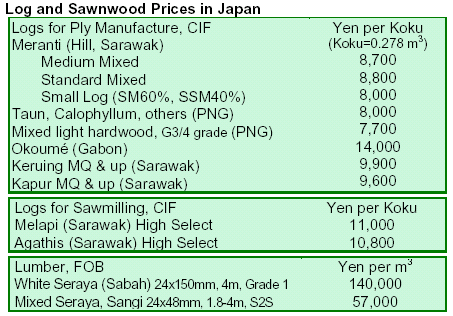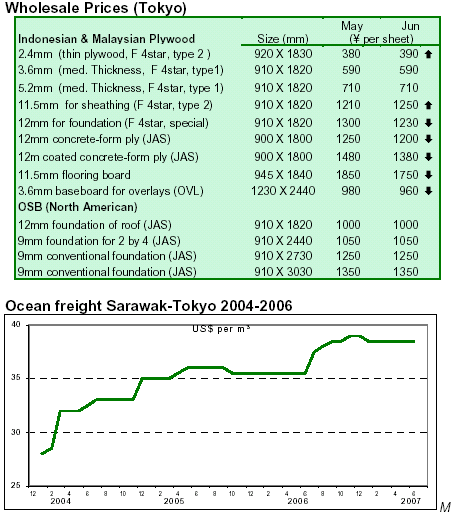|
Japan
Wood Products Prices
Dollar
Exchange Rates of 15th May
2007
Japan
Yen 123.12
Reports
From Japan
Japan plywood situation remains unchanged
Prices of plywood have not changed since the rainy season started in Japan. Stocks of plywood are still larger than
expected and cargo movements have been stagnant. However, thick items of softwood plywood had
maintained their price levels. Distribution wholesalers are hoping business will change for the better due to April’s
improved housing starts, and that prices will recover once some plywood stock have been moved out. Big contracts
for plywood have not been established, mainly because of high prices in Malaysia and Indonesia.
Manufacturers, trading companies and distributors met to discuss the sluggish plywood market. They said that
although thick items had been selling well and demand had been met for precut orders of softwood plywood, there
could be a shortage of Lauan lumber in the future. Buyers had been making infrequent purchases and, combined with
oversupply of lumber, the market had been weak. Some observed rising prices for thick products as a result of the
construction industry’s reduction of the amount of flooring used in order to cut costs.
Government expands focus on biomass fuel
The government of Japan has set near and long-term targets to increase production of domestic biomass fuel.
By 2030, the government hopes that technology can be used to produce bioethanol from materials including lumber and rice straw. The Ministry of Agriculture,
Forestry and Fisheries estimated that up to 1,300,000 kiloliters could be produced from wood based raw
materials and would contribute to forestry management and conservation. The initiative, in
addition to preventing global warming, would help revitalize regions and promote employment.
Housing industry seeks ways to ease lumber supply
At a seminar on the Imported House Industries Organization, Kitaoji Yasunobu of Polus-Tec Inc. noted
that the company’s profits dropped to half due to the higher cost of wages, wood and land. He said that to ease
the pressure, a new product could help avert “wood shock”. Fast growing
varieties of trees currently being grown in the South East Asia area might help ease thepressure on wood supply in the future. Additionally,
technological innovations would improve manufacturing processes to ensure the future supply of lumber products.
Japan imported more plywood in April
Japan’s imports of plywood increased 4.4% from a year earlier. The statistics, based on
information from the Japan Plywood Manufacturers’ Association, revealed that
Malaysia and Indonesia had exported more to Japan than in March, up 0.5% and 0.7% respectively. China’s exports
to Japan also grew 25.4% in April. Domestically, Japan continued to generate more
outputs of pure softwood plywood although the quantity of its shipments decreased.
Overall, Japan’s imports plus domestic production showed an upward trend of 2.6%, and the percentage of imported
plywood products from March to April grew 58.4%.
Japan calls for compliance with JAS
The Japanese Ministry of Agriculture, Forestry and Fisheries investigated a number of overseas manufacturers
of structural laminated lumber to check their compliance with Japan Agricultural Standards (JAS). The
investigations revealed that the structural strength of several manufacturers’ products was near the lower limits
of JAS. Although the Ministry found no plant in violation of JAS, many manufacturers’ products were one rank
lower grade in strength. The Ministry advised that the quality of the standards should be improved to comply
with revised JAS (as of 1 March 2006), and said it would undertake periodic checks on overseas manufacturers in
the future.
Weather and high prices drag down demand for South Sea logs
The Supply of South Sea logs and Japanese demand for logs continued to be weak. Japanese plywood mills and
Chinese buyers were reducing their purchase of South Sea logs, and supply was low due to poor weather conditions
in the region.
Japan reduced its purchase of small meranti logs, although these logs were being purchased at the local level, so
prices had not dropped drastically. There had been some inquiries for plantation logs by Japanese plywood mills.
Malaysian prices for logs had been too high for Japanese buyers.

Imported plywood faces market slowdown
Although arrivals of imported plywood were low, the market for imported plywood has continued to fall since
late May. This is mainly due to the weak demand after prices for plywood steeply increased last year. To reduce
currently high levels of inventories, wholesalers are cutting prices.
Tokyo Wholesale Market remains sluggish
Wholesalers are concerned that a liquidation of stock in the form of a “slaughter sale” may occur due to business
inactivity. At a meeting on 6 June, wholesalers expressed concern about the
lack of movement in the market. Reasons for the fears were delays in the issuance of
construction certifications, lack of shipments of stock, and “cash strapped” companies.
Nevertheless, they had hope that shipments would commence soon and the market would
recover.
Specifically, for imported timber, prices for Malaysian logs were bullish and imports of perupok and agathis laminated lumber remained small.

|